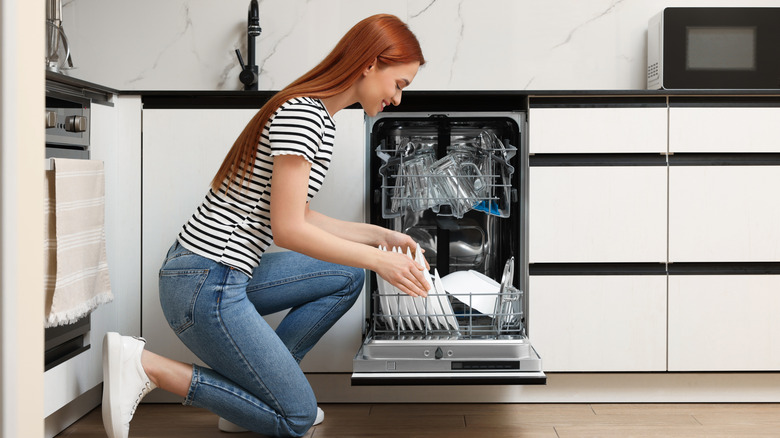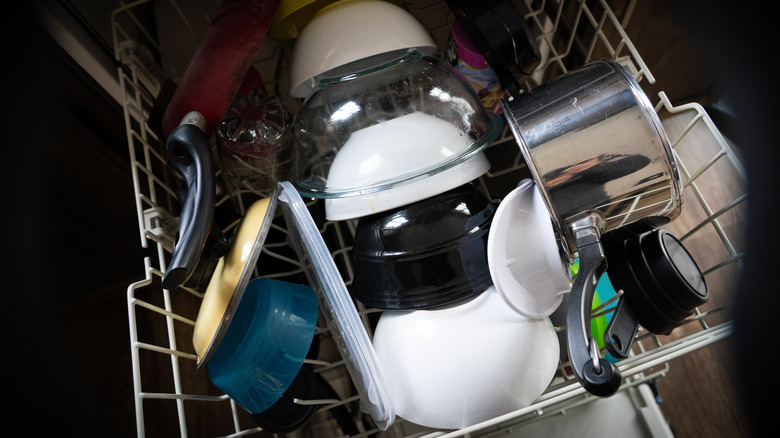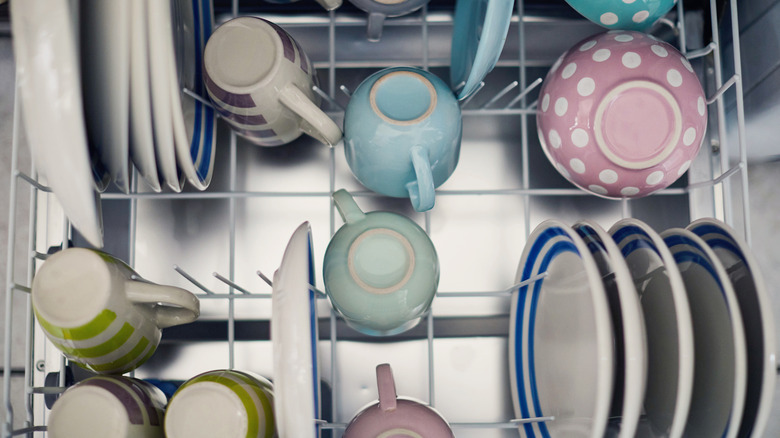The Worst Mistake You Can Make With A Small Dishwasher
With the ability to reach high temperatures during the cleaning cycle, dishwashers are more effective at cleaning and sanitizing dishes to remove germs and bacteria than hand washing, which usually has a maximum temperature lower than what is needed to sanitize. Newer dishwashers are also more energy efficient than hand washing, as running a full dishwasher uses significantly less water than hand washing those same dishes. So, if you want an efficient and effective clean, dishwashers are the obvious choice. A small dishwasher is better than no dishwasher at all, but if you are loading your compact dishwasher incorrectly, you may be left washing by hand anyway. One particular problem is placing plates and other large items horizontally on the top shelf or overhanging the tower sprayer on the bottom shelf.
Unfortunately, mistakes made while loading your dishwasher, particularly if it is a small one, can negate the benefits. The loading method for a dishwasher of any size has a major impact on its ability to clean all of the dishes effectively, and this is only amplified for small dishwashers, which tempt users to add more than the dishwasher can actually fit. Loading issues can be particularly detrimental if your small dishwasher uses a tower sprayer design, as poor loading means that some items will block water from reaching other dishes and result in an ineffective cycle. Because you will need to wash the dishes again after running the cycle, you will lose the efficiency that makes your dishwasher a good choice. If you want to take advantage of the benefits of your dishwasher, you will need to load it properly.
Why incorrectly loading a small dishwasher is a problem
If you are in need of troubleshooting tips for a dishwasher that is not cleaning well, one place to start is by looking at your dishwasher's design. Standard dishwashers are 24 inches wide, but you can buy smaller models that are less than 18 inches wide to fit into compact spaces. While many dishwashers have sprayer arms at both the top and bottom of the dishwasher to rotate and spray the dishes, some small dishwashers have a tower design.
The tower style has a sprayer arm at the bottom of the dishwasher and a telescoping tower that extends and supplies water to the top rack instead of a top sprayer arm. Because the water comes up at the dishes from the bottom and then falls back down, it is important to place items so they do not block the water. A large plate, bowl, pot, pan, or other dish placed horizontally on the top rack, or too many dishes placed on the rack, will cause the water to splash off of the large dish straight back down towards the sprayer rather than circulating around to hit the other dishes.
If the thought of having to hand wash dishes that have already been through a wash cycle does not convince you to avoid the mistake of laying items horizontally and overloading your dishwasher, then the potential damage might. Overloading your dishwasher can cause strain on its motor, potentially resulting in damage over time. To avoid the hassle and make your dishwasher last longer, it is much simpler to load your dishwasher properly and hand wash large items.
How to load a small dishwasher properly
To load a small dishwasher properly, start with the bottom rack. Place items vertically between the prongs on the rack with the dirty side facing the sprayers when possible. Larger pans, cutting boards, and serving dishes, if they fit in the dishwasher, should be placed vertically on the bottom rack in the back or along the sides of the dishwasher so they do not block the dish detergent. Make sure that no dishes on the bottom rack block the spray tower — placing plates or other large items near the arm or allowing anything to lean over the arm could keep it from extending. For the top rack, place glassware, cups, bowls, and dishwasher-safe plastic items so that the soiled side faces the sprayers. If you have a third, smaller rack at the very top of your dishwasher, you may encounter the same water-blocking issue from either the top or bottom, so make sure any items you place on the third rack will not block the sprayers.
Just like large dishes can obstruct water flow, so too can nesting. Nesting occurs when items like bowls or spoons sit too close together facing the same direction. The back of one dish blocks the front of another from getting hit by the water, leaving both items still dirty. If you load your dishwasher with the design of the sprayers in mind, you should get a more effective and efficient clean. Knowing how to avoid the mistake of overloading your dishwasher with horizontal dishes is just one of many ways to use your dishwasher better.


